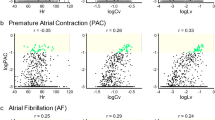Abstract
Most systems for the automatic detection of abnormalities in the ECG require prior knowledge of normal and abnormal ECG morphology from pre-existing databases. An automated system for abnormality detection has been developed based on learning normal ECG morphology directly from the patient. The quantisation error from a self-organising map ‘learns’ the form of the patient's ECG and detects any change in its morphology. The system does not require prior knowledge of normal and abnormal morphologies. It was tested on 76 records from the European Society of Cardiology database and detected 90.5% of those first abnormalities declared by the database to be ischaemic. The system also responded to abnormalities arising from ECG axis changes and slow baseline drifts and revealed that ischaemic episodes are often followed by long-term changes in ECG morphology.
Similar content being viewed by others
References
Andrew, J., Hopkirk, J., Leader, S., Uhl, G. S., Hickman, J. R., andFischer, J. (1984): ‘Limitation of exercise-induced R wave amplitude changes in detecting coronary artery disease in asymptomatic men’,J. Amer. College Cardiol.,3, pp. 821–826
Bezerianos, A., Vladutu, L., andPapadimitriou, S. (2000): ‘Hierarchical state space partitioning with a network self-organizing map for recognition of ST-T segment changes’,Med. Biol. Eng. Comput.,38, pp. 406–415
Bonoris, P. E., Greenberg, P. S., Christison, G. W., Castellanet, M. J., andEllestad, M. H. (1978): ‘Evaluation of R wave amplitude changes versus ST-segment depression in stress testing’,Circulation,57, pp. 904–910
David, D., Naito, M., Michelson, E., Watanbe, Y., Chen, C. C., Morganroth, J., andShaffenburg, M. (1982): ‘Intramiocardial conduction: a major determinant of R-wave amplitude during acute myocardial ischaemia’,Circulation,65, pp. 161–167
Fernández, E. A., Presedo, J., andBarro, S. (1999): ‘An ECG ischemic detection system based on self-organizing maps and sigmoid function pre-processing stage’,Artificial Intelligence in Medicine. Lecture Notes in Artificial Intelligence,1620, pp. 207–216 (Springer-Verlag, Berlin, Heidelberg, New York, 1999)
Ham, F. M., andSoowham, H. (1996): ‘Classification of cardiac arrhythmias using fuzzy ARTMAP’,IEEE Trans. Biomed. Eng.,43, pp. 425–430
Jager, F., Moody, G. B., andMark, R. G. (1998): ‘Detection of transient ST segment episodes during ambulatory ECG monitoring’,Comput. Biomed. Res.,31, pp. 305–322
Kohonen, T. (1997): ‘Self-organizing maps’ (Springer-Verlag, Berlin, Heidelberg, New York, 1997), 2nd edn
Laguna, P., Moody, G. B., García, J., Goldberger, A. L., andMark, R. G. (1999): ‘Analysis of the ST-T complex of the electrocardiogram using the Karhunen-Loeve transform: adaptive monitoring and alternans detection’,Med. Biol. Eng. Comput.,37, pp. 175–189
Laister, M. J., andRiggs, R. J. (1984): ‘A comparison of template matching and feature extraction of ECG analysis’ in ‘Computers in cardiology 1984’ (IEEE Computer Society Press), pp. 101–104
Maglaveras, N., Stamkopoulos, T., Diamantaras, K., Pappas, C., andStrintzis, M. G. (1998a): ‘ECG pattern recognition and classification using non-linear transformations and neural networks: a review’,Int. J. Med. Informatics,52, pp. 191–208
Maglaveras, N., Stamkopoulos, T., Pappas, C., andStrintzis, M. G. (1998b): ‘An adaptive backpropagation neural network for real-time ischemic episodes detection: development and performance analysis using the European ST-T database’,IEEE Trans. Biomed. Eng.,45, pp. 805–813
Moody, G. B., andMark, R. G. (1982): ‘Development and evaluation of a 2-lead ECG analysis program’ in ‘Computers in cardiology 1982’, pp. 39–44
Myers, J., Ahnve, S., Froelicher, V., andSullivan, M. (1985): ‘Spatial R wave amplitudes changes during exercise: relation with left ventricular ischaemia and function’,J. Amer. College Cardiol,6, pp. 603–608
Ng, F., Wong, S., Almeida, D., Mora, F., Hernandez, A., andPassariello, G. (1997): ‘Diagnostic value of R wave amplitude changes in coronary artery disease’ in ‘Computers in cardiology 1997’ (IEEE Computer Society Press), pp. 457–460
Polak, M. J., Zhou, S. H., Rautaharju, P. M., Armstrong, W. W., andChaitman, B. R. (1995): ‘Adaptive logic network compared with backpropagation network in automated detection of ischaemia from resting ECG’ in ‘Computers in cardiology 1995’ (IEEE Computer Society Press), pp. 217–220
Presedo, J., Fernández, E. A., Vila, J., andBarro, S. (1996a) ‘Cycles of ECG parameter evolution during ischemic episodes’ in ‘Computers in cardiology 1996’, pp. 489–492
Presedo, J., Vila, J., Barro, S., Palacios, F., Ruiz, R., Taddei, A., andEmdim, M. (1996b): ‘Fuzzy modelling of the expert's knowledge in ECG-based ischaemia detection’,Fuzzy Sets Syst.,77, pp. 63–75
Rappaport, S. H., Gillick, L., Moody, G. B., andMark, R. G., (1982): ‘QRS morphology classification: quantitative evaluation of different strategies’ in ‘Computers in cardiology 1982’, pp. 33–38
Silipo, R., andMarchesi, C. (1996): ‘Neural networks architecture for extensive long term ECG analysis’ in ‘Computers in cardiology 1996’, pp. 13–16
Silipo, R., Laguna, P., Marchesi, C., andMark, R. G. (1995): ‘ST-T segment change recognition using artificial neural networks and principal component analysis’ in ‘Computers in cardiology 1995’, pp. 213–216
Taddei, A., Biagini, G., Emdim, M., Mazzei, M. G., Pisani, P., Roggero, N., Varanini, M., Mark, R. G., Moody, G. B., Braaksma, L., Zeelenberg, C., andMarchesi, C. (1991): ‘The European ST-T Database: development, distribution and use’ in ‘Computers in cardiology 1991’ (IEEE Computer Society Press), pp. 177–180
Taddei, A., Constantin, G., Silipo, R, Emdim, M., andMarchesi, C. (1995): ‘A system for the detection of ischemic episodes in ambulatory ECG’ in ‘Computers in cardiology 1995’ (IEEE Computer Society Press), pp. 705–708
Taddei, A., Varanini, M., Macerata, A., Emdim, M., andMarchesi, C. (1992): ‘Detection of ischemic episodes through principal component analysis’,Biotelemetry,XII, pp. 77–84
Thakor, N., Gramatikov, B., andMita, M. (1993): ‘Multiresolution wavelet analysis of ECG during ischaemia and reperfusion’ in ‘Computers in cardiology 1993’ (IEEE Computer Society Press), pp. 895–898
Vila, J., Presedo, J., Delgado, M., Barro, S., Ruiz, R., andPalacios F. (1997): ‘SUTIL: intelligent ischaemia monitoring system’,Int. J. Med. Informatics,47, pp. 193–214
Wang, J. Y. J. (1983): ‘Application of pattern recognition techniques to QRS complex classification—a review’ in ‘Computers in cardiology 1983’ (IEEE Computer Society Press), pp. 77–82
Author information
Authors and Affiliations
Corresponding author
Rights and permissions
About this article
Cite this article
Fernández, E.A., Willshaw, P., Perazzo, C.A. et al. Detection of abnormality in the electrocardiogram without prior knowledge by using the quantisation error of a self-organising map, tested on the European ischaemia database. Med. Biol. Eng. Comput. 39, 330–337 (2001). https://doi.org/10.1007/BF02345288
Received:
Accepted:
Issue Date:
DOI: https://doi.org/10.1007/BF02345288




